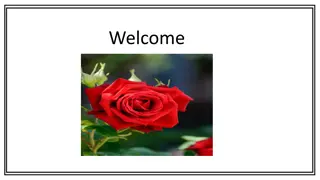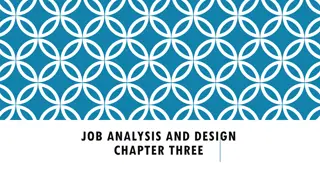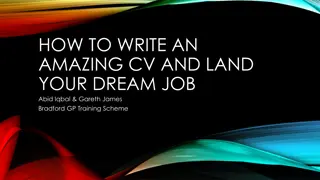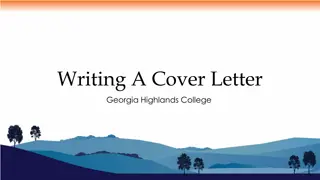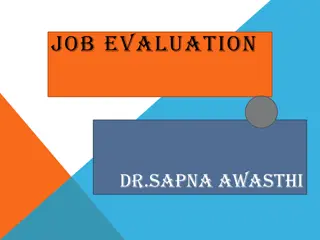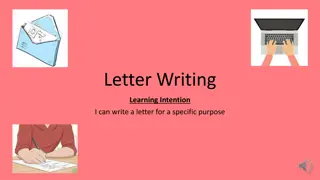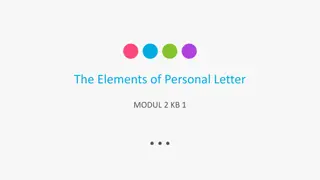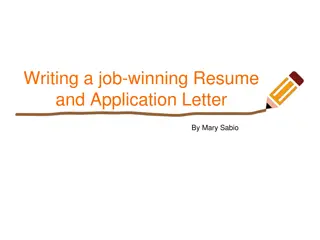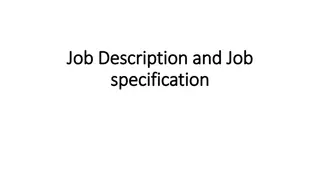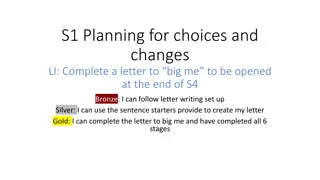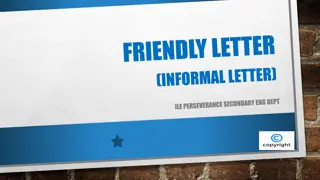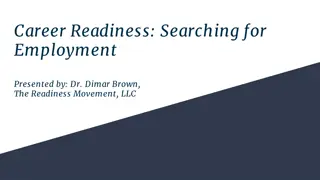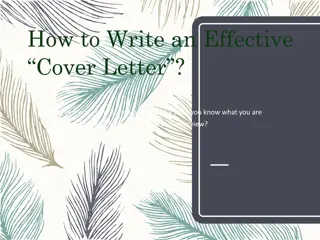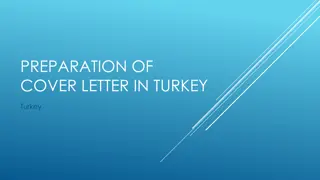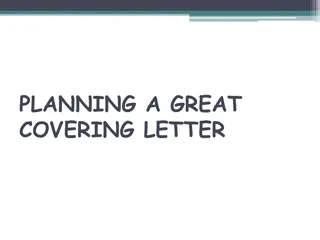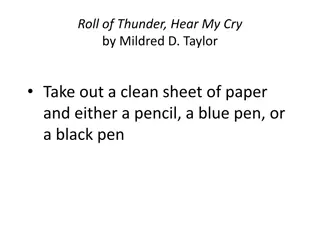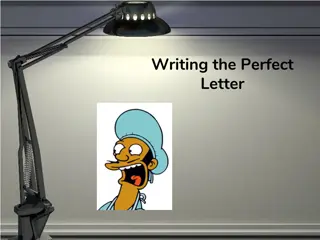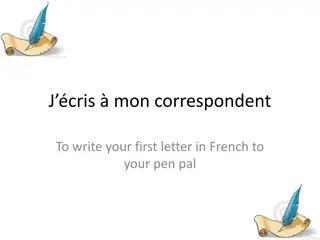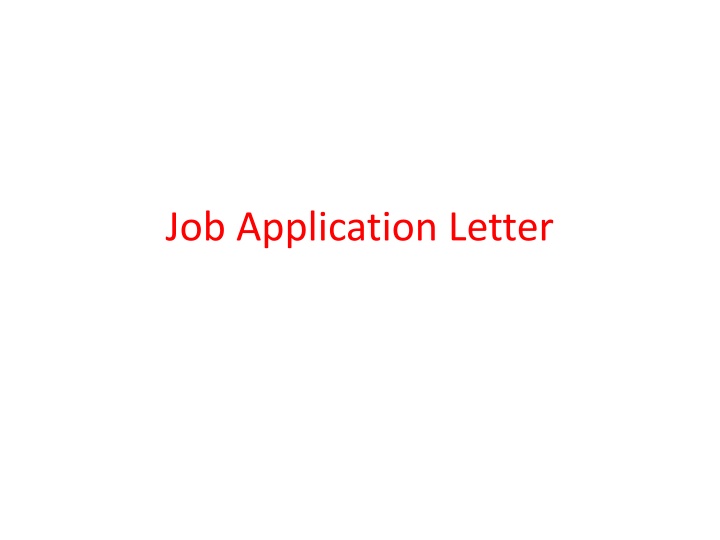
Crafting an Impressive Job Application Letter: Key Tips for Success
Learn how to make your job application letter purposeful, people-oriented, and precise to impress potential employers. Understand the importance of tailoring your message to the employer's perspective to increase your chances of securing an interview and standing out from the competition.
Download Presentation

Please find below an Image/Link to download the presentation.
The content on the website is provided AS IS for your information and personal use only. It may not be sold, licensed, or shared on other websites without obtaining consent from the author. If you encounter any issues during the download, it is possible that the publisher has removed the file from their server.
You are allowed to download the files provided on this website for personal or commercial use, subject to the condition that they are used lawfully. All files are the property of their respective owners.
The content on the website is provided AS IS for your information and personal use only. It may not be sold, licensed, or shared on other websites without obtaining consent from the author.
E N D
Presentation Transcript
3 PS: PURPOSEFUL, PEOPLE-ORIENTED, PRECISE An effective business letter is noted for its purposeful, people-oriented, and precise qualities. It becomes purposeful when the sender writes with a definite purpose in mind. Unlike an informal letter written to a friend, where you can write without a real business purpose except the sheer fun of sharing interesting ideas, you write a professional letter only when you have something to convey. It should be people- oriented, that is, it is completely audience-oriented. So, you should know your reader before-hand. If necessary, you should research on your reader to know what will interest him/her.
In case of the job application, your audience happens to be the employer, the review committee, and the panel that is going to interview you. The committee that shortlists candidates for the interview should find something impressive about your letter, be its style or content or both. You need to focus totally on them by taking their perspective. How do you take that perspective? Ask yourself whether the other person who is going to read it will find it interesting. Will s/he find it impressive? If you were you to play the role of a short-listing panelist, what would you find convincing enough to take your candidature to the interview
level? Honestly, if you cannot find it impressive, then how can you expect the panel to find it impressive? Then what should you do to make it impressive? So put yourself in their shoes, focus on improving your application in such a manner that it catches their attention, sustains their interest, and makes them give you the desired response in this case sending you the call letter for the interview!
An easy way to make your letter impressive is by following the golden rule of business communication: be precise. Being precise implies being concise, clear, coherent, and careful in choosing words. Every word should be appropriately selected. The whole body should be constructed word by word just like the way a building is constructed brick by brick. Not a single word could easily be removed from your writing. It should be so tersely organized that if a word is removed, the whole letter should not make much sense. Conversely, if your letter makes sense even by removing paragraphs and sentences, it means your writing is very loose, unorganized, and will certainly induce boredom for the reader
WHY JOB-APPLICATION LETTER? Why should you send a formal job-application letter? Why can t you just send an SMS and ask them: Hey guys, download my cv and upload the interview letter, please. Or, just send a simple text message: Give me a chance for interview. Obviously, you understand you can t afford to be as informal as sending an SMS to your likely employer. A letter, as such, is a written record; as most of the business communication is record-oriented, it is significant to send something that can be kept in a permanent manner. Moreover, most of the employers like a conservative format, and it is always safe to use the letter format.
A job-application letter fulfils three business purposes. The first and the chief purpose of a job- application letter is that it serves the function of a cover letter. Thus, it introduces the R sum or Bio-data or CV, gives a preview to the reader, creates interest in them and suggests what to expect. In case, where a separate CV is not demanded, it functions as a CV. Secondly, the job- application letter highlights the strengths of the candidate to the employer. Thirdly, it tries to secure an interview for the candidate.
FEATURES What are the basic features of a job-application letter? A job-application letter, like a sales letter, tries to a sell the candidate s talents and skills. It highlights the best of the candidate and tries to beat the competition at the outset itself. It includes brief information about education, experience, extracurricular activities, and names and contact details of referees.
COVER LETTER WITH CV/BIO-DATA The details are shortened if it is a mere cover letter with an enclosed CV/Bio-data/R sum as in the following format.
DIFFERENCES BETWEEN BIO-DATA, CV AND RSUM Let us try to understand the differences between Bio-data, CV and R sum . Unfortunately, often these three terms are being used synonymously or mistakenly one term is used for the other. Thus when a six page CV/Bio-data is expected, people send a one page R sum and frustrate the employer. Bio-data is short for biographical data. It has the implication of a shortened version of autobiography. Hence, the candidate is expected to give a chronological perspective that comprises date of birth, background, education, career, aspirations, extracurricular, etc. It
includes complete factual details about the candidates life and work experiences. This is the major difference between Bio-data, CV and R sum . The items in the Bio-data are serialized, even serial number is given. Since it follows a chronological order, it starts with the first thing first, that is, name, father s name, date of birth, and so on. What is the logic behind it? You must be surprised to know that the term bio-data has come from the field of psychology where the past information is collected to predict the future performance. That is why bio-data includes physical attributes such as age, height, weight, even in some cases, the colour of hair, skin and eye. Usually, it is combined with the latest passport size photograph of the candidate. The usage of Bio-data functionally originates from the British and is practised commonly in India. Whereas, R sum is typically American, in which, personal, family, social, and religious backgrounds are ignored.
CV, is short for curriculum vitae, a Latin phrase, which literally means the course of life. It is taken to mean one s career graph or career progress. The focus here is more on the career. It is an overview of a person s experience and other qualifications. It is a long synoptic account of the candidate s professional experience, qualifications, and some personal information. Although some personal information is added, the larger perspective is on the career progress. The emphasis of the information changes according to the particular position applied. The usage once again is British and is commonly used in India.
But now a days, Rsum has become much more popular than CV and Bio-data. R sum , meaning summary in French, is a short descriptive account of one s academic and work history. The life details are very minimal, almost nothing in this. R sum is a document containing a focused sketch of relevant job experience and education. It is often synonymously treated with CV, though it is shorter than a CV. We will be looking at CV and R sum in detail in the next lecture. Meanwhile, let me conclude this lecture with the outline of a Bio-data.

